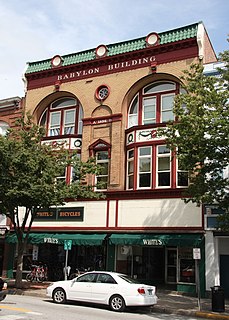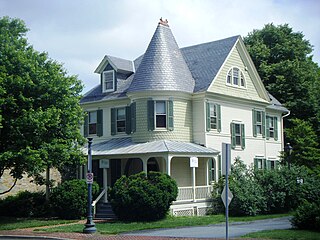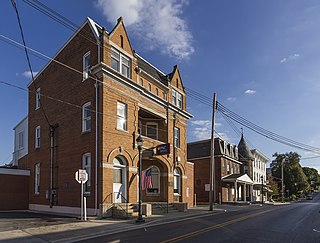
Doughoregan Manor is a plantation house and estate located on Manor Lane west of Ellicott City, Maryland, United States. Established in the early 18th century as the seat of Maryland's prominent Carroll family, it was home to Charles Carroll, a signer of the United States Declaration of Independence, during the late 18th century. A portion of the estate, including the main house, was designated a National Historic Landmark on November 11, 1971. It remains in the Carroll family and is not open to the public.

St. Charles College was a minor seminary in Catonsville, Maryland, originally located in Ellicott City, Maryland.

Seton Hill Historic District is a historic district in Baltimore, Maryland. It was listed on the National Register of Historic Places in 1975.

The Westminster Historic District comprises the historic center of Westminster, Maryland. The district includes about 1400 structures, with a high proportion of contributing structures. The town exhibits a variety of building styles and notable examples of Greek Revival, Georgian, and Gothic Revival style architecture. Most of the structures exhibit early 19th-century residential vernacular architecture and mid-19th century commercial architecture.

The Seneca Historic District is a national historic district located at Poolesville, Montgomery County, Maryland. The district comprises 3,850 acres (1,560 ha) of federal, state, and county parkland and farmland in which 15 historic buildings are situated. The Chesapeake and Ohio Canal, including Seneca Aqueduct, Lock No. 24, the adjacent lock house; as well as the Seneca Quarry and quarry masters house above the quarry also stand within the district and are also within Seneca Creek State Park. The 15 historic structures are surrounded by dependencies of various periods, in most cases dating from the period of the dwelling. There are slave quarters, smokehouses, springhouses, corn cribs, and tobacco barns.

The West Montgomery Avenue Historic District is a national historic district located at Rockville, Montgomery County, Maryland. It is a residential area with single-family homes predominating. The majority of the properties within the district date from the 1880s, with a few older homes and somewhat more from later periods. The predominant character of the district is set by the rows of Victorian houses built between 1880 and 1900 in a vernacular residential mode with Eastlake and Stick Style influences. Also included in the district are attorneys' offices; churches and parsonages; a funeral home; the former Woodlawn Hotel, later called the Chestnut Lodge Sanitarium ; and the headquarters of the Montgomery County Historical Society.

The Savage Mill Historic District is a national historic district located at Savage, Howard County, Maryland. The district comprises the industrial complex of Savage Mill and the village of workers' housing to the north of the complex.

The Inns on the National Road is a national historic district near Cumberland, Allegany County, Maryland. It originally consisted of 11 Maryland inns on the National Road and located in Allegany and Garrett counties. Those that remain stand as the physical remains of the almost-legendary hospitality offered on this well-traveled route to the west.
Castle Hall is a historic home, formerly part of a larger farm of the same name. The home itself is on a 5.739 acre parcel that was subdivided from the farm in the late 20th century. The surrounding farm, still used for agricultural purposes, is located in Goldsboro, Caroline County, Maryland, and covers 676 acres. The main structure is a three-part "telescope" house, so called because it was built in stages, with each successive addition being smaller than the previous one. The original 2+1⁄2-story portion is the largest of the three parts and stands at the northeast end. The smallest of the three parts is constructed of both wood framing and brick, unlike the rest of the structure which is almost entirely brick. It was built by Thomas Hardcastle in 1781.

The McKinstry's Mills Historic District is a national historic district in Union Bridge, located in Carroll and Frederick County, Maryland. The district comprises the entirety of the settlement of McKinstry's Mills, a 26-acre (110,000 m2) hamlet consisting of six separate properties that were owned and developed in the 19th century by the McKinstry family, local millers. At the center is a 3+1⁄2-story grist mill constructed in 1844. Also included are the McKinstry homestead, built between 1825 and 1835; the residence of miller Samuel McKinstry, dated 1849; a store building of 1850; and two other small houses and a variety of outbuildings. There is also a 1908 Warren pony truss bridge.

St. Francis Xavier Church, or Old Bohemia, is a historic Roman Catholic church located at Warwick, Cecil County, Maryland, United States. It is located on what was once the Jesuit estate known as Bohemia Manor.

Avondale is a historic home located at Westminster, Carroll County, Maryland. It is a Georgian style, 2+1⁄2-story brick house, measuring approximately 45 feet long by 18+1⁄2 feet deep, built about 1796. The house has a two-story wing measuring approximately 49 feet long by 13 feet deep. It features a Palladian window centered on the pavilion directly over the entrance door.

Farm Content is a historic home located at Westminster, Carroll County, Maryland, United States. It is a two-story brick structure, five bays wide at the principal façade and built about 1795. It is one of the finest examples of rural Federal architecture in Carroll County, and as the home of David Shriver, progenitor of the Shriver family in Maryland.

Carroll County Almshouse and Farm, also known as the Carroll County Farm Museum, is a historic farm complex located at Westminster, Carroll County, Maryland. It consists of a complex of 15 buildings including the main house and dependencies. The 30-room brick main house was originally designed and constructed for use as the county almshouse. It is a long, three-story, rectangular structure, nine bays wide at the first- and second-floor levels of both front and rear façades. It features a simple frame cupola sheltering a farm bell. A separate two-story brick building with 14 rooms houses the original summer kitchen, wash room, and baking room, and may have once housed farm and domestic help. Also on the property is a brick, one-story dairy with a pyramidal roof dominated by a pointed finial of exaggerated height with Victorian Gothic "icing" decorating the eaves; a large frame and dressed stone bank barn; and a blacksmith's shop, spring house, smokehouse, ice house, and numerous other sheds and dependencies all used as a part of the working farm museum activities. The original Carroll County Almshouse was founded in 1852 and the Farm Museum was established in 1965.

Lineboro Historic District is a national historic district at Lineboro, Carroll County, Maryland, United States. It comprises most of the village of Lineboro. In addition to a number of 19th and early 20th century homes, also present are agricultural outbuildings, including bank barns. Public, commercial, and industrial buildings include several stores, a one-room school and a fire hall. Other buildings of interest include the former hotel, a feed mill, and the 1908 cruciform-plan Gothic Revival Lazarus Union Church. The district comprises a total of 83 resources, of which 70, or 84%, contribute to its significance.

Linwood Historic District is a national historic district at Linwood, Carroll County, Maryland, United States. The district includes a mixture of railway structures, community structures and residences with rural dependencies. They date to the 19th and early-20th century and most structures relate to Linwood's role as a rail depot for the transportation of farm goods and supplies.

Taneytown Historic District is a national historic district at Taneytown, Carroll County, Maryland, United States. The district comprises a cohesive group of houses, churches, commercial buildings and industrial structures reflecting the development of this crossroads town from its initial platting in 1762 through the early 20th century.

Union Bridge Historic District is a national historic district at Union Bridge, Carroll County, Maryland, United States. The district consists of this small piedmont village, which serves the area as a market center for the surrounding agricultural area. The greatest growth occurred in the 1880s after the Western Maryland Railway built its shops here.

Union Bridge station is a historic railway station in Union Bridge, Carroll County, Maryland. It was built in 1902 as a stop for the Western Maryland Railway. It is representative of the rural railway stations constructed during the late 19th and early 20th centuries. The station's two buildings are arranged with their south façades lengthwise fronting the railroad tracks.
Charlestown Historic District is a national historic district at Charlestown, Cecil County, Maryland, United States. It consists of a 150-acre (0.61 km2) portion of the town containing all known existing 18th century features. There are 14 houses known to have been constructed during that century and its largest structures were the inns and hotels which served the popular Charlestown Fair in the colonial period.






















